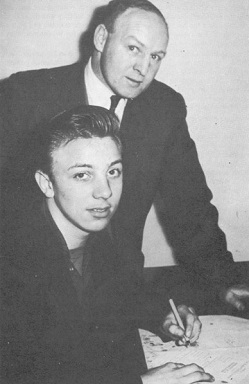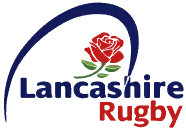Related Research Articles
Robert Dennis "Bobbie" Goulding, also known by the nickname of "Bobbie Dazzler", is an English former professional rugby league footballer, and coach, who played in the 1980s, 1990s, 2000s and 2010s, and has coached in the 2000s and 2010s.
Alexander James Murphy OBE is an English former professional rugby league footballer, and coach of the mid to late 20th century. Known as 'Murphy the Mouth' and regarded as one of the greatest halfbacks in the history of the British game, he represented Great Britain in 27 Tests and his club career was played at three clubs, St. Helens, Leigh and Warrington. Murphy assumed a player-coach role of the last two clubs and expanded his coaching role toward the end of his playing career to include clubs such as Wigan, Salford and Huddersfield. He later returned to both Warrington and Leigh respectively as a football manager. He was the first player to captain three different clubs to victory in the Challenge Cup Final.
Eric Hughes is a retired English rugby union and professional rugby league footballer who played in the 1960s, 1970s and 1980s, and coached rugby league in the 1980s and 1990s. He played representative level rugby union (RU) for England (Under-15s), and representative level rugby league (RL) for Great Britain and England, and at club level for Widnes, Canterbury-Bankstown Bulldogs, St Helens and the Rochdale Hornets, as a wing, centre or stand-off, and coached at club level for Widnes, Rochdale Hornets, St Helens, Leigh and Wigan Warriors. He unwittingly added confusion to the Canterbury-Bankstown Bulldogs team as he was unrelated but played at the same time as the three Australian brothers named Hughes; Garry, Graeme and Mark.
Thomas Kelvin Coslett is a Welsh former dual-code international rugby union and professional rugby league footballer who played in the 1960s and 1970s, and coached rugby league in the 1970s and 1980s. He played representative level rugby union (RU) for Wales, and at club level for Aberavon RFC and Llanelli RFC, as a goal-kicking full-back, and representative level rugby league (RL) for Wales and Other Nationalities, and at club level for St. Helens (captain), and Rochdale Hornets, as a toe-end kicking style goal-kicking fullback, prop, second-row, or loose forward, and coached at club level for Rochdale Hornets, Wigan and St. Helens.
John Charles Bevan is a Welsh international rugby footballer of the 1970s and 1980s. He is one of two John Bevans who played for Wales during the 1970s.
Steve Nash is an English former professional rugby league footballer who played in the 1960s, 1970s and 1980s, and coached in the 1980s. A Great Britain and England national representative and scrum-half, he played his club rugby for Featherstone Rovers, winning a Challenge Cup title with them and being one of the inaugural inductees into the club's hall of fame. He also played for the Salford club and at representative level for Yorkshire. Nash later coached the Mansfield Marksman club for a season in 1989.
John Mantle was a Welsh dual-code international rugby player. He was capped for Wales at rugby union, and Great Britain and Wales in rugby league.
Kevin Ashcroft is a former professional rugby league footballer who played in the 1960s and 1970s, and coached in the 1970s, 1980s and 1990s. He played at representative level for Great Britain and Lancashire, and at club level for the Rochdale Hornets, Dewsbury, Leigh, Warrington and Salford, as a hooker. and coached at club level for Leigh and Salford. Ashcroft is a Warrington Hall of Fame inductee.

David Chisnall was an English professional rugby league footballer who played in the 1970s and 1980s. He played at representative level for Great Britain and England, and at club level for Leigh, Warrington (captain), Swinton, St. Helens and Barrow, as a prop.
Keith John Fielding is an English dual-code international rugby union, and professional rugby league footballer who played in the 1960s, 1970s and 1980s as a winger. He played representative level rugby union for England, and at club level for Moseley Rugby Football Club before switching to rugby league in 1973, and went on to play representative level rugby league for Great Britain and England, and at club level for Salford.
Kenneth Gill is an English former professional rugby league footballer who played in the 1970s and 1980s. He played at representative level for Great Britain and England, and at club level for Salford, Widnes and Barrow, as a stand-off.

John Parry-Gordon was an English professional rugby league footballer who played in the 1960s, 1970s and 1980s. He played at representative level for England and Lancashire, and at club level for Warrington, as a scrum-half.
Derek Noonan was an English rugby union and professional rugby league footballer who played in the 1970s and 1980s. He played club level rugby union (RU) for St Helens RUFC, as a wing, i.e. number 11 or 14, and representative level rugby league (RL) for England and Lancashire, and at club level for Warrington, St. Helens and Fulham RLFC, as a centre, i.e. number 3 or 4.
Barry Philbin is an English former professional rugby league footballer who played in the 1970s. He played at representative level for England, and at club level for Swinton and Warrington, as a loose forward, i.e. number 13, during the era of contested scrums. He subsequently broke his leg, which he puts down to playing in jersey number unlucky 13.
Alan Whittle is a former professional rugby league footballer who played in the 1960s and 1970s. He played at club level for St Helens, Barrow, Warrington, and Wigan, as a wing, centre, stand-off, or scrum-half.
Peter Banner is an English former professional rugby league footballer who played as a scrum-half in the 1960s and 1970s. He played at representative level for Wales, and at club level for Salford, Featherstone Rovers and Leeds.
Robert Wanbon was a Welsh dual-code international rugby union and professional rugby league footballer who played in the 1960s and 1970s. He played representative level rugby union (RU) for Wales, and at club level for Aberavon RFC, as a number eight, and representative level rugby league (RL) for Wales, and at club level for St. Helens and Warrington, as a prop, or second-row, i.e. number 8 or 10, or, 11 or 12, during the era of contested scrums.

The Lancashire County Rugby Football Union is the society responsible for rugby union in the county of Lancashire, England, and is one of the constituent bodies of the national Rugby Football Union having been formed in 1881. In addition it is the county that has won the County Championship on most occasions
Eric Prescott was an English rugby union, and professional rugby league footballer who played in the 1960s, 1970s and 1980s. He played club level rugby union (RU) for Widnes ICI RUFC, and representative level rugby league (RL) for Lancashire, and at club level for St Helens, Salford, Widnes and Runcorn Highfield, as a wing, centre, second-row or loose forward. He was the father of England international rugby league player, Steve Prescott.
The 1966–67 BBC2 Floodlit Trophy was the second occasion on which the BBC2 Floodlit Trophy competition had been held.
References
- 1 2 3 4 5 6 Tom Brophy Profile on scrum.com
- ↑ "Player Summary: Tom Brophy". Rugby League Records. Rugby League Record Keepers Club. Retrieved 11 March 2024.
- 1 2 3 Stars to spare in the golden period, Rochdale Observer, 13 January 2003
- ↑ John Griffiths, On This Day - October, at scrum.com
- ↑ Northwest Evening Mail, Published at 10:49, Saturday, 11 July 2009 Archived 4 March 2012 at the Wayback Machine
- ↑ Platt, Darrell (1991). A History of Salford Rugby League Club. Salford Rugby League Club.